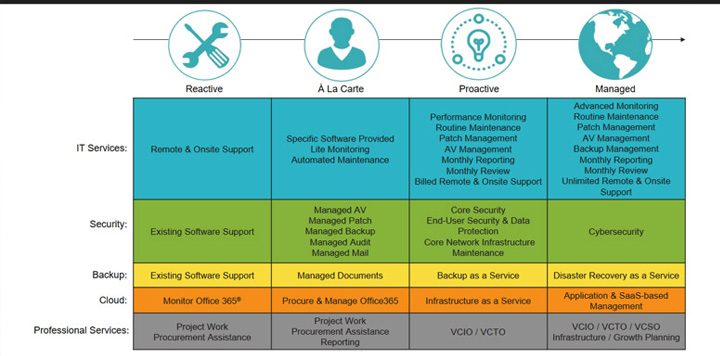Understanding Today’s Most Successful MSP Programs

In her recent webinar for the MSP Institute’s Business Training program, Stefanie Hammond, senior channel sales specialist at SolarWinds MSP, guided viewers through the various types of MSP packages we have seen successfully implemented in the marketplace as well as taking an in-depth look at the feature-sets typically included at each level.
 “Having well-defined service offerings is imperative,” says Hammond. “Not only will it help streamline the sales process for your sales team and your clients, but it will also improve and streamline how you deliver those services out of your network operation center (NOC). Thus helping you to accelerate your customer growth and profitability levels for your business.”
“Having well-defined service offerings is imperative,” says Hammond. “Not only will it help streamline the sales process for your sales team and your clients, but it will also improve and streamline how you deliver those services out of your network operation center (NOC). Thus helping you to accelerate your customer growth and profitability levels for your business.”
The reality is there are opportunities for managed services everywhere. However, the best targets are those businesses that are about 100 employees or less and do not have an internal IT department or internal IT resource. “This is where you can build out support programs to specifically target these types of organizations that don’t have the in-house technical expertise,” explains Hammond. “Aligning your support packages based on your prospects’ overall budget, support requirements, and any other support expectations helps you ensure you sell more.”
Defining Customer Segments
There are four main customer segments IT service providers offer:
 Break/Fix This is typically a fee-for-service model where the customer picks up the phone whenever they have a problem and asks for help. The service provider then works on the issue and provides some sort of resolution to their network computer issue. Once the issue is resolved, that customer is then invoiced at a pre-negotiated time and materials rate.Under this model, there are no customer ties to the provider’s organization—there are no contracts in place and therefore no stickiness or loyalty (even if you are their preferred vendor). These are often your ‘least’ mature type of customer, typically shying away from any sort of ‘contract’ arrangement because they are extremely cost-conscious and feel that being under a ‘managed services contract’ is going to be too expensive for them.This is a very unpredictable source of revenue for your business, as you cannot provide services, and subsequently cannot bill for those services, until there is a problem and that phone rings.
Break/Fix This is typically a fee-for-service model where the customer picks up the phone whenever they have a problem and asks for help. The service provider then works on the issue and provides some sort of resolution to their network computer issue. Once the issue is resolved, that customer is then invoiced at a pre-negotiated time and materials rate.Under this model, there are no customer ties to the provider’s organization—there are no contracts in place and therefore no stickiness or loyalty (even if you are their preferred vendor). These are often your ‘least’ mature type of customer, typically shying away from any sort of ‘contract’ arrangement because they are extremely cost-conscious and feel that being under a ‘managed services contract’ is going to be too expensive for them.This is a very unpredictable source of revenue for your business, as you cannot provide services, and subsequently cannot bill for those services, until there is a problem and that phone rings.- A La CarteThe ‘A La Carte’ customer is a small step up from break/fix customers. They are slightly more mature in their thinking around network services, in that they are beginning to think about putting some sort of budget in place for IT support services. These customers are often starting to get frustrated with the unpredictable cost of repairs and the perception that it takes too long to fix problems when they arise. As such, they tend to be more willing to spend a little bit each month for things they deem necessary.
- Proactive SupportThe proactive customer is the first one that can help drive substantial recurring revenue for your business. Unlike break/fix and A La Carte customers, Proactive customers are very much aware of how important their network is to the overall success of their business and therefore, they are aware that they need to be ‘proactive’ in how they care for their network. They are generally very receptive to hearing about managed services and more willing to pay for contracted support.
- Managed ServicesIt is here that service providers can productize their contracts and support packages and convert them into an all-inclusive, fixed-fee model that is truly the pinnacle of managed services. At this level, the service provider assumes 100% of the risk, but that risk is greatly diminished by using a cohesive, standard suite of monitoring, automation, security, and data protection tools across every one of their customers.Because the service provider is assuming all the risk, in return, they can charge a premium, and therefore reap huge rewards in terms of the highest levels of profitability and business evaluations for their organization. This is the best type of customer to have, as they absolutely understand that the stability and performance of their network is critical, and that any amount of network downtime costs their organization time and money.
Defining your service offering
 Over the years, we have seen service providers develop to provide five distinct categories of services within each of these customer segments:
Over the years, we have seen service providers develop to provide five distinct categories of services within each of these customer segments:
- IT Support Services
- Security Services
- Backup and Data Protection Services
- Cloud Services
- Professional Services
This webinar takes a detailed look at the four customer market segments and how each of these five services is included and managed. By outlining the most popular programs that we are seeing successfully sold in the market today, we are aiming to help new or emerging managed service providers (MSPs) understand what to ‘sell’ and how much to charge, as well as helping existing MSPs looking for ideas on how to revamp or restructure what they are currently selling.
Watch the full webinar here and discover how creating a set of standard programs helps to simplify your sales and marketing process, and allows you to ‘upgrade’ services and increase the amount you charge your customers today.
Want to stay up to date?
Get the latest MSP tips, tricks, and ideas sent to your inbox each week.
